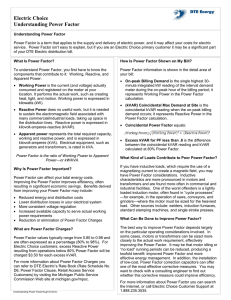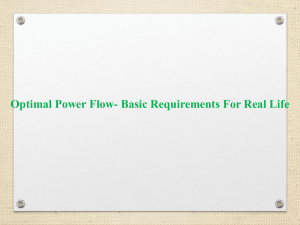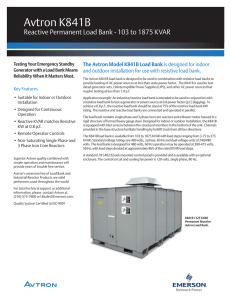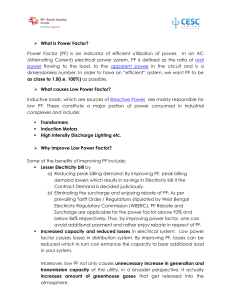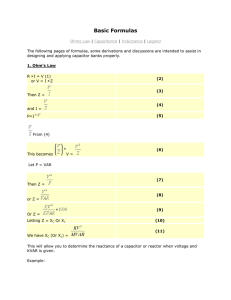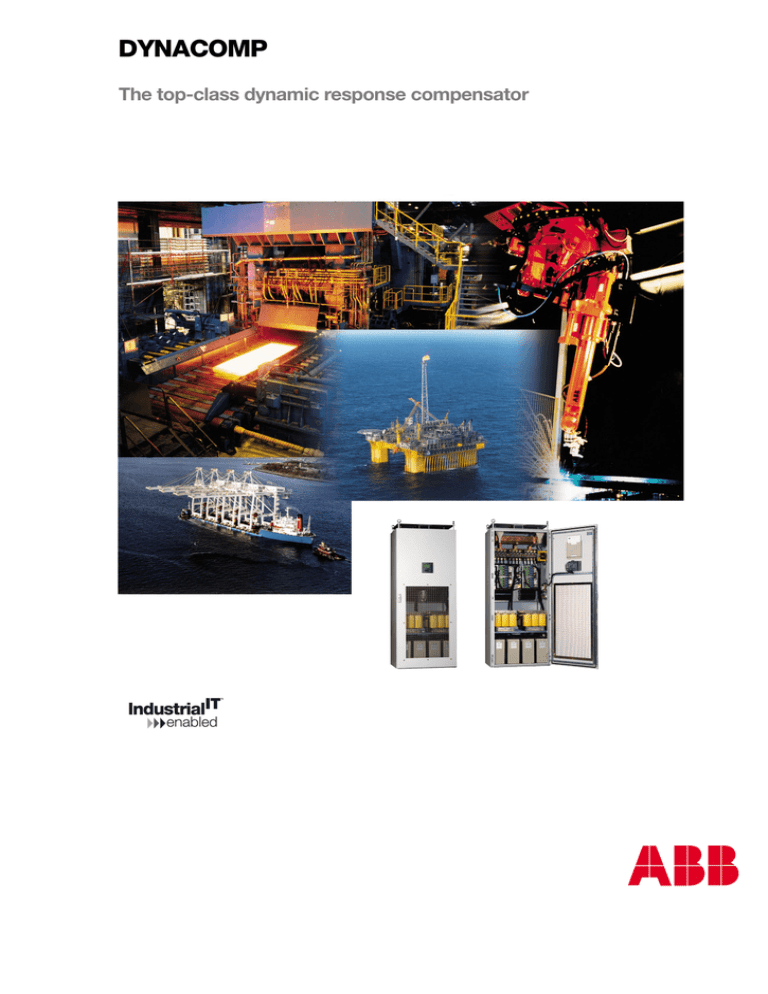
DYNACOMP
The top-class dynamic response compensator
Reactive power and power quality
Excessive reactive power drawn by linear- and nonlinear loads deteriorates the Power Quality of the
network in a variety of ways. This leads to reduced
running efficiency and production quality of plants and
an increased running cost.
High reactive power demand by the load results in a
low displacement power factor (cos ϕ). This may lead
to financial losses due to penalties imposed by the
supply utility. In addition, the resulting higher current
creates additional losses in the supply network making
it operate less efficiently and also shortens the lifetime
of the network components (e.g. cables, transformers,
etc.) due to the increased electrical and thermal stress.
High reactive power flow results in an unstable bus
voltage, which may have severe effects on productivity.
When the reactive power demand is fluctuating due to
fluctuating loads, this may lead to flicker which is
potentially harmful to the human health.
Traditionally, low cos ϕ problems are solved using fixed
or contactor switched capacitor banks. However, loads
whose reactive power demand is high and/or has a
rapidly changing pattern, cannot be adequately
compensated by these solutions. Examples of such
loads include thyristor converters used in harbour cranes,
rubber mixers, extrusion lines, compressors, offshore
drilling applications etc, welding loads used in the
automobile industry etc. and motors of large capacity
which draw a very high starting current.
Some of the main problems created by these loads are:
Voltage sags and undervoltage resulting in production halt
Flicker
Low cos ϕ resulting in penalties and network overload
High harmonic levels generated by non-linear loads
The ABB Dynacomp which uses fast static switches and
advanced microprocessor based technology is best suited
to compensate such loads and take care of the abovementioned problems. The transient free switching,
which is not possible with contactor switched capacitor
banks, incorporated in each Dynacomp ensures smooth
and reliable operation for even the most sensitive
networks. A properly selected detuning reactor also
helps in harmonic absorption, thereby reducing the
voltage distortion.
Flicker
Flicker is defined as a phenomena of rapid voltage variations
which cause change in the intensity of light leading to irritation
to the human eye.
These voltage variations are mainly caused by fast varying
load which draws high reactive power from the supply network
and thereby causes voltage drop across the network impedance
as given below:
ΔV1 = Rnetwork. Ip + Xnetwork . Iq
where ΔV1 is the real part of the voltage drop at the PCC
Ip and Iq are the active and the reactive contributions
of the load current
Rnetwork is the resistive part of the network impedance
Xnetwork is the reactive part of the network impedance
V0
Δ V
Xnetwork
1
Rnetwork
Ip, Iq
PCC
Loads
2
In a “strong” network, the resistive part is generally small and
the corresponding voltage drop is negligible. However, in a
“weak” network where line resistance is significant, even the
active part of the current may result in significant voltage drop.
The voltage drop ΔV1 can be compensated by a dynamic
compensator connected in parallel to the load providing the
following capacitive current :
1
Icompensator = Iq+ Q
. Ip
network
where Icompensator is the current injected by the compensator
Ip and Iq are the active and the reactive contributions
of the load current
Qnetwork is the quality factor of the supply network
( = Xnetwork/Rnetwork)
A normal compensator cannot control flicker efficiently as it
is designed to compensate only the reactive part of the load
current. ABB’s advanced controller RVT-D has a special feature
to compensate even for the voltage drop due to the line
resistance and active part of the current.
The Dynacomp controller type RVT-D allows the user to set
the desired X/R value in order to compensate fully the voltage
drop ΔV1 under all operating conditions.
ABB
Dynacomp: principle
The Dynacomp is a circuit consisting of capacitors and
reactors switched on the network by solid state power
electronics, without any moving part. A three-phase
Dynacomp circuit is represented here. Single- phase
Dynacomps can also be provided. The Dynacomp can
compensate low voltage equipment for nominal
voltages from 380V up to 690V.
The thyristors are fired at the natural zero crossing of
the capacitive current. As a result, capacitors are
connected to the network without transients.
The control is such that only complete alternations of the
current are allowed. This ensures that no harmonics or
transients are generated by the Dynacomp.
Dynacomp advantages
Ultra-rapid power factor compensation
Reduction of voltage drop and flicker
Transient free switching
Very high number of switching operations
Modular and compact standardized design
Easy to install and extend
Advanced communication features with Modbus
Power steps from 100 to 400 kvar
Up to 32 power steps with CAN control bus
Harmonics absorption
ABB micro-processor based RVT-D controller
Network measurements, including harmonics
Direct connection up to 690V
ABB large field experience
ISO 9001 certification
ISO 14001 certification
ABB
3
Dynacomp vs electromechanical switching of capacitors
Electromechanical switching
of capacitors
The Dynacomp: the top-class
dynamic compensator
"" Transient free switching
Transients at switching
Conventional banks with contactors are switched on when
reactive power is needed, but the precise instant of
switching is not controlled. This has the consequence that
the switching of the capacitors results in a big transient.
This transient disturbs the electrical network, is dangerous
for the contactors and increases the stress on the
capacitors. The disturbance created in the voltage
waveform could affect sensitive equipment. This is shown
in the figure below, where an 80 kvar step is switched
on by contactors. The current reaches 3640 A peak which
is approximately twelve times the nominal 304 A peak.
The Dynacomp, fitted with static switches instead of
contactors, is the perfect choice in applications where
transient-free switching is required. It will not cause
disturbances to sensitive networks or neighbouring
equipment. The figure below shows the switching of
an 80 kvar step using the static switch of the Dynacomp.
The current reaches only 304 A peak, i.e. the nominal
value.
Current waveform when switching a conventional bank
Current waveform when switching a Dynacomp
with contactors (transient)
(no transient)
Slow response time
"" Fast response time
load demand
output of contactor switched bank
40s
Limited life
Time
load demand
output of Dynacomp
Time
"" Long life
Contactors have a limited lifetime and need to be
replaced regularly. Such systems also require important
maintenance efforts.
4
The powerful control of the Dynacomp and its switching
concept allows dynamic response times less than two
network periods for power factor correction, less than
one network period for voltage drop compensation and
virtually instantaneous if an external signal is available.
Reactive power
Reactive power
Electromechanically switched power factor correction
systems are fitted with discharge resistors. This allows
reducing the voltage difference between the capacitors
and the network and consequently the magnitude of the
transients. Discharging the capacitors takes tens of
seconds and tremendously limits the response time of
such system, without suppressing the transients.
The transient free switching (with no electric arc, no
moving parts) combined with the self healing capacitors
used in the Dynacomp guarantees a very long life time
of the system without any limitation in the number of
switching operations.
ABB
Dynacomp: description
The Dynacomp consists of capacitors, reactors,
Dynaswitches and the electronic control system. These
components are mounted in a cubicle together with
auxiliary apparatus to form a factory assembled and
tested system.
The Dynacomp is a standard product, designed to suit
all possible requirements of a fast varying load. Wide
network voltage range, flexible power range, modular
design, choice of detuning reactors etc. are some of the
features which make the Dynacomp the ideal solution
for all applications needing a fast and smooth switching
of reactive power.
RVT-D controller
Dynaswitches
Reactors
Capacitors
(CLMD type)
RVT-D controller
Micro-processor based, the RVT-D is designed to meet
the specific needs of the customer :
for accurate and fast power factor compensation.
for minimum response time allowing mitigation of
voltage drops and flicker effects.
The RVT-D has features including:
full graphics display with backlighting.
network measurements: voltage, current, THDV,
THDI, harmonics spectrum, Dynacomp current,
powers and more.
programmable protection thresholds (undervoltage,
overvoltage, overtemperature, excessive harmonic
distortion and power outage).
a help button giving instant access to a description
of all RVT-D’s features and functionality.
a printer connection.
Modbus communication.
Modbus communication
The Modbus feature allows communication with a
monitoring system. All RVT-D parameters are available
(including harmonic spectrum and tables) through an RS485
Modbus adapter. All RVT-D parameters are accessible
through Modbus and the locking switch allows to limit their
access through the Modbus communication only.
ABB
5
CLMD capacitors
The ABB CLMD capacitor consists of a number of wound elements made with a dielectric of metallized polypropylene
film. It offers the following advantages:
Dry type design
Unique sequential protection system
The CLMD has a dry type dielectric and therefore cannot
give any risk of leakage or pollution to the environment.
A unique sequential protection system ensures that each
individual element can be disconnected from the circuit
at the end of its life.
In-house metallized film
The dry dielectric of the CLMD is made of ABB
in-house metallized polypropylene film giving:
- High voltage withstand capability
- Excellent peak current handling capacity
- High capacitance stability
- Long life even under high electrical stress
- Very low losses
- Exceptional self-healing properties
Heavy duty
enclosure
Thermal equalizer
Capacitor element:
- dry dielectric
- self-healing
- very low losses
Vermiculite
High level of safety
Capacitor elements are encapsulated in a thermo-setting
resine and placed in a sheet steel box filled with
inorganic, inert and fire proof granules (vermiculite) that
will absorb the energy produced or extinguish any flames
in case of a possible defect at the end of an element's
life. Thermal equalizers are fitted to surround each
capacitor element and provide effective heat dissipation.
Wire connection
Metal end spray
In-house metallised
polypropylene film
(unique profile)
Secondary foil winding
Biaxially oriented
polypropylene dielectric
Thermo-setting encapsulation
Fuse link
Plastic case
ABB Reactors
Most applications where dynamic reactive power
compensation is required, are associated with non-linear
loads, producing significant harmonics. In order to
safeguard the capacitors from harmonic overloading and
also to perform limited filtering action, the capacitors
in the Dynacomp are provided with a suitable detuning
reactor. The choice of the detuning reactor is based on
our long experience, to suit the actual harmonic
spectrum present in different type of loads.
6
Reactors are iron cored with copper or aluminium
windings and copper terminals. Units are completely
impregnated under vacuum and overpressure in a
polyester resin and dried in furnace.
The reactors are designed for heavy industrial environments. For extremely polluted networks, re-inforced
reactors are offered as an option.
ABB
Dynaswitches
The Dynaswitch is the electronic switch of the
Dynacomp controlling the connection of the
capacitors to the network.
The Dynaswitch is composed of two pairs of backto-back high power thyristor modules, governing
the passage of current.
As only full alternations of current are allowed, the
Dynaswitch does not act as a classical AC thyristor
valve for which the firing pulses of the thyristors are
chosen to modulate the current. It plays the role of a
classical mechanical interrupter, with the possibility
to choose explicitly the closing instant. The interest
is to avoid transients. The opening instant occurs at
zero crossing of the current, as thyristors are used.
The Dynaswitch is also equipped with its own
cooling device, ensuring a normal working
temperature for the semiconductors. The complete
system is protected by fuses.
The improved Dynaswitch controller allows CAN
bus communication and offers a compact design.
It also enhances error reporting.
Dynacomp: applications
Motor start
The high reactive power demand during a motor start
creates undesired voltage drop on low voltage side as
well as on the medium voltage side.
In the figures below, 5 steps of 250 kvar are switched on
for the compensation of a 375 kVA motor of a high
pressure refrigeration compressor.
Without Dynacomp
ABB
The voltage drops on the high voltage and creates
problem in the neighbouring companies.
The Dynacomp solution allows to fulfill the voltage drop
limit on the high voltage side imposed by the utility
company.
With Dynacomp
7
Harbour crane
Switching of charged capacitors result in large transients
when the capacitor and network voltages are in phase
opposition at the closing instant. This is why
conventional banks always have delays (~1 minute)
between switching on/off the capacitors. This delay
permits the discharge of the capacitors through discharge
resistors, but limits the utilisation of conventional
capacitor banks for rapidly fluctuating loads requiring
frequent switchings.
During its cycle, a crane requires variable amounts of
reactive power. The whole crane cycle lasts about one
minute. Compensation with conventional banks is not
possible for this operation: the cycle is too short and
the required reactive power is too large. The Dynacomp
improves the power factor by reducing the reactive
current drawn from the grid. This also results in reduced
current drawn from the supply system. The presence
of 7% detuning reactor helps in harmonic absorption
which is reflected in reduced THDV levels.
As the switching of the Dynacomp does not require the
discharge of the capacitors, the utilisation of the
Dynacomp for the compensation of any load with rapid
variations is possible.
Reactive Power (kvar) with and without Dynacomp
Total harmonic voltage distortion (THDV)
with and without Dynacomp
Welding machine
Welding equipment typically draws high welding current
for a very short time. As a result, the repetitive
impermissible voltage variations may result.
In the figures below, 4 steps of 150 kvar are switched on
for the compensation of a 210 kVA single phase welder
with the use of an external signal for instantaneous
response time (voltage drop compensation).
These figures show clearly that the voltage drop due to the
welding machine is totally reduced. Perturbation to
Without Dynacomp
8
sensitive devices like PLC, computers, lighting, ... are
avoided.
In addition to this positive effect, the quality of the welding
is considerably improved leading to a better quality of
the final product. At the same time the power
consumption of the production line is significantly lowered.
With Dynacomp
ABB
Rolling mill
Rolling mill normally employs large DC drives where
the metal is rolled from billets to various sheet
thicknesses. The load on the network depends on the
type of “Pass” and grade of material being rolled. A
typical load cycle lasts from a few minutes to several
minutes during which the reactive power demand varies
rapidly.
A classical solution employing contactors as switching
device can not properly compensate the load of a rolling
mill. The Dynacomp due to its superior performance is
the ideal solution for rolling mill applications.
The Dynacomp successfully performs the task of reactive
compensation, reducing the reactive power drawn from
the supply network and hence improving the power
factor. The reduced line current helps in loss reduction
of the overall system. The reduced voltage distortion
due to harmonic absorption by the Dynacomp is an
added advantage. The stable bus voltage means a better
quality of the finished product. All these add to the
overall efficiency of the complete system.
Reactive Power (kvar) with and without Dynacomp
Total harmonic voltage distortion (THDV)
with and without Dynacomp
Oil drilling platform
Offshore platforms normally use onboard generators to
power the electrical loads. These loads consume high
active power (kW) at very low cos ϕ implying a very
high reactive (kvar) power. As a result, most of these
platforms run more number of generators than needed
to meet the active power (kW) demand. This results in
high operation and maintenance costs of the generators.
A suitably rated Dynacomp relieves the generators from
extreme reactive power burden and lets them operate at
optimal cos ϕ. This results in a significant reduction in
load current to be supplied by the generators and as a
consequence some of the generators can be switched
off. It gives direct benefit in terms of saved fuel and
maintenance cost apart from other benefits thanks to
the improved cos ϕ.
Line current (Irms) with and without Dynacomp
ABB
9
Dynacomp: three-phase range
Frequency: 50 Hz
Frequency: 60 Hz
380V [1]/400V - 50Hz - 3-phase (with 7% reactor)
Power per cubicle Step size Sequence
Designation
(kvar)
380V - 60Hz - 3-phase (with 7% reactor)
Power per cubicle Step size Sequence
Designation
(kvar)
200
200
300
300
400
400
400
100
200
100
100
100
200
100
1:1
1
1:1:1
1:2
1:1:1:1
1:1
1:1:2
CLMQ-M20-V40F5N3-22
CLMQ-M20-V40F5N3-11
CLMQ-M30-V40F5N3-33
CLMQ-M30-V40F5N3-32
CLMQ-M40-V40F5N3-44
CLMQ-M40-V40F5N3-22
CLMQ-M40-V40F5N3-43
415V - 50Hz - 3-phase (with 7% reactor)
Power per cubicle Step size Sequence
Designation
(kvar)
200
200
300
300
400
400
400
100
200
100
100
100
200
100
1:1
1
1:1:1
1:2
1:1:1:1
1:1
1:1:2
CLMQ-M20-V41F5N3-22
CLMQ-M20-V41F5N3-11
CLMQ-M30-V41F5N3-33
CLMQ-M30-V41F5N3-32
CLMQ-M40-V41F5N3-44
CLMQ-M40-V41F5N3-22
CLMQ-M40-V41F5N3-43
525V - 50Hz - 3-phase (with 7% reactor)
Power per cubicle Step size Sequence
Designation
(kvar)
180
180
270
270
360
360
360
90
180
90
90
90
180
90
1:1
1
1:1:1
1:2
1:1:1:1
1:1
1:1:2
CLMQ-M18-V52F5N3-22
CLMQ-M18-V52F5N3-11
CLMQ-M27-V52F5N3-33
CLMQ-M27-V52F5N3-32
CLMQ-M36-V52F5N3-44
CLMQ-M36-V52F5N3-22
CLMQ-M36-V52F5N3-43
600V - 50Hz - 3-phase (with 7% reactor)
Power per cubicle Step size Sequence
Designation
(kvar)
200
200
300
300
400
400
400
400
100
200
100
100
100
200
100
400
1:1
1
1:1:1
1:2
1:1:1:1
1:1
1:1:2
1
CLMQ-M20-V60F5N3-22
CLMQ-M20-V60F5N3-11
CLMQ-M30-V60F5N3-33
CLMQ-M30-V60F5N3-32
CLMQ-M40-V60F5N3-44
CLMQ-M40-V60F5N3-22
CLMQ-M40-V60F5N3-43
CLMQ-M40-V60F5N3-11
200
200
300
300
400
400
400
100
200
100
100
100
200
100
1:1
1
1:1:1
1:2
1:1:1:1
1:1
1:1:2
CLMQ-M20-V38F6N3-22
CLMQ-M20-V38F6N3-11
CLMQ-M30-V38F6N3-33
CLMQ-M30-V38F6N3-32
CLMQ-M40-V38F6N3-44
CLMQ-M40-V38F6N3-22
CLMQ-M40-V38F6N3-43
480V - 60Hz - 3-phase (with 7% reactor)
Power per cubicle Step size Sequence
Designation
(kvar)
180
180
180
270
360
360
360
90
180
180
90
90
180
90
1:1
1
1
1:2
1:1:1:1
1:1
1:1:2
CLMQ-M18-V48F6N3-22
CLMQ-M18-V48F6N3-11
CLMQ-M18-V48F6N3-11
CLMQ-M27-V48F6N3-32
CLMQ-M36-V48F6N3-44
CLMQ-M36-V48F6N3-22
CLMQ-M36-V48F6N3-43
600V - 60Hz - 3-phase (with 7% reactor)
Power per cubicle Step size Sequence
Designation
(kvar)
200
200
300
300
400
400
400
400
100
200
100
100
100
200
100
400
1:1
1
1:1:1
1:2
1:1:1:1
1:1
1:1:2
1
CLMQ-M20-V60F6N3-22
CLMQ-M20-V60F6N3-11
CLMQ-M30-V60F6N3-33
CLMQ-M30-V60F6N3-32
CLMQ-M40-V60F6N3-44
CLMQ-M40-V60F6N3-22
CLMQ-M40-V60F6N3-43
CLMQ-M40-V60F6N3-11
660V[3]/690V - 60Hz - 3-phase (with 7% reactor)
Power per cubicle Step size Sequence
Designation
(kvar)
200
200
300
300
400
400
400
400
100
200
100
100
100
200
100
400
1:1
1
1:1:1
1:2
1:1:1:1
1:1
1:1:2
1
CLMQ-M20-V69F6N3-22
CLMQ-M20-V69F6N3-11
CLMQ-M30-V69F6N3-33
CLMQ-M30-V69F6N3-32
CLMQ-M40-V69F6N3-44
CLMQ-M40-V69F6N3-22
CLMQ-M40-V69F6N3-43
CLMQ-M40-V69F6N3-11
660V[2]/690V - 50Hz - 3-phase (with 7% reactor)
Power per cubicle Step size Sequence
Designation
(kvar)
200
200
300
300
400
400
400
400
[1]
[2]
[3]
10
100
200
100
100
100
200
100
400
1:1
1
1:1:1
1:2
1:1:1:1
1:1
1:1:2
1
CLMQ-M20-V69F5N3-22
CLMQ-M20-V69F5N3-11
CLMQ-M30-V69F5N3-33
CLMQ-M30-V69F5N3-32
CLMQ-M40-V69F5N3-44
CLMQ-M40-V69F5N3-22
CLMQ-M40-V69F5N3-43
CLMQ-M40-V69F5N3-11
400V, 50Hz rated cubicles can be used at 380V, 50Hz with 10% derating on output power (e.g. 100 kvar step at 400V, 50 Hz
will deliver 90 kvar at 380V, 50 Hz)
690V, 50Hz rated cubicles can be used at 660V, 50Hz with 10% derating on output power (e.g. 100 kvar step at 690V, 50 Hz
will deliver 90 kvar at 660V, 50 Hz)
690V, 60Hz rated cubicles can be used at 660V, 60Hz with 10% derating on output power (e.g. 100 kvar step at 690V, 60 Hz
will deliver 90 kvar at 660V, 60 Hz)
ABB
Dynacomp: single-phase range
Frequency: 50 Hz
Frequency: 60 Hz
380V[1]/400V - 50Hz - 1-phase (with 14% reactor)
Power per cubicle Step size Sequence
Designation
(kvar)
380V - 60Hz - 1-phase (with 14% reactor)
Power per cubicle Step size Sequence
Designation
(kvar)
200
300
400
100
100
100
1:1
1:1:1
1:1:1:1
CLMQ-M20-V40F5N1-22
CLMQ-M30-V40F5N1-33
CLMQ-M40-V40F5N1-44
415V - 50Hz - 1-phase (with 14% reactor)
Power per cubicle Step size Sequence
Designation
(kvar)
200
300
400
100
100
100
1:1
1:1:1
1:1:1:1
CLMQ-M20-V41F5N1-22
CLMQ-M30-V41F5N1-33
CLMQ-M40-V41F5N1-44
600V - 50Hz - 1-phase (with 14% reactor)
Power per cubicle Step size Sequence
Designation
(kvar)
200
200
300
300
400
400
100
200
100
100
100
200
1:1
1
1:1:1
1:2
1:1:1:1
1:1
CLMQ-M20-V60F5N1-22
CLMQ-M20-V60F5N1-11
CLMQ-M30-V60F5N1-33
CLMQ-M30-V60F5N1-32
CLMQ-M40-V60F5N1-44
CLMQ-M40-V60F5N1-22
660V[2]/690V - 50Hz - 1-phase (with 14% reactor)
Power per cubicle Step size Sequence
Designation
(kvar)
200
200
300
300
400
400
[1]
[2]
[3]
100
200
100
100
100
200
1:1
1
1:1:1
1:2
1:1:1:1
1:1
CLMQ-M20-V69F5N1-22
CLMQ-M20-V69F5N1-11
CLMQ-M30-V69F5N1-33
CLMQ-M30-V69F5N1-32
CLMQ-M40-V69F5N1-44
CLMQ-M40-V69F5N1-22
200
300
400
100
100
100
1:1
1:1:1
1:1:1:1
CLMQ-M20-V38F6N1-22
CLMQ-M30-V38F6N1-33
CLMQ-M40-V38F6N1-44
480V - 60Hz - 1-phase (with 14% reactor)
Power per cubicle Step size Sequence
Designation
(kvar)
200
200
300
300
400
400
100
200
100
100
100
200
1:1
1
1:1:1
1:2
1:1:1:1
1:1
CLMQ-M20-V48F6N1-22
CLMQ-M20-V48F6N1-11
CLMQ-M30-V48F6N1-33
CLMQ-M30-V48F6N1-32
CLMQ-M40-V48F6N1-44
CLMQ-M40-V48F6N1-22
600V - 60Hz - 1-phase (with 14% reactor)
Power per cubicle Step size Sequence
Designation
(kvar)
200
200
300
300
400
400
100
200
100
100
100
200
1:1
1
1:1:1
1:2
1:1:1:1
1:1
CLMQ-M20-V60F6N1-22
CLMQ-M20-V60F6N1-11
CLMQ-M30-V60F6N1-33
CLMQ-M30-V60F6N1-32
CLMQ-M40-V60F6N1-44
CLMQ-M40-V60F6N1-22
660V[3]/690V - 60Hz - 1-phase (with 14% reactor)
Power per cubicle Step size Sequence
Designation
(kvar)
200
200
300
300
400
400
100
200
100
100
100
200
1:1
1
1:1:1
1:2
1:1:1:1
1:1
CLMQ-M20-V69F6N1-22
CLMQ-M20-V69F6N1-11
CLMQ-M30-V69F6N1-33
CLMQ-M30-V69F6N1-32
CLMQ-M40-V69F6N1-44
CLMQ-M40-V69F6N1-22
400V, 50Hz rated cubicles can be used at 380V, 50Hz with 10% derating on output power (e.g. 100 kvar step at 400V, 50 Hz
will deliver 90 kvar at 380V, 50 Hz)
690V, 50Hz rated cubicles can be used at 660V, 50Hz with 10% derating on output power (e.g. 100 kvar step at 690V, 50 Hz
will deliver 90 kvar at 660V, 50 Hz)
690V, 60Hz rated cubicles can be used at 660V, 60Hz with 10% derating on output power (e.g. 100 kvar step at 690V, 60 Hz
will deliver 90 kvar at 660V, 60 Hz)
The Dynacomp cubicles are designated as follows:
CLMQ-Caa-VbbFcNd-XY
X = electrical step(s) (1 to 4)
Y = physical output(s) (1 to 4)
Nd = phase configuration where N1 = single-phase and N3 = three-phase
Fc = network frequency where F5 = 50 Hz and F6 = 60 Hz
Vbb = cubicle rated voltage, where bb = the two first digits of the nominal voltage
Caa = type and rated power of the cubicle, where C = M (for Master) or S (for Slave) cubicle
and aa = the two first digits of the rated power in kvar
CLMQ = designation for Dynacomp
Example:
CLMQ–M30–V69F5N3–32 designates a Dynacomp (CLMQ), master cubicle of 300 kvar (M30) rated for 690V
network voltage (V69), 50 Hz (F5), three-phase (N3). The 300 kvar rated power is delivered in three steps
of 100 kvar each (3) with 2 physical outputs of respectively 100 and 200 kvar (2).
The Dynacomp modular design allows any combination of above cubicles with the same characteristics
(i.e. voltage, frequency, % reactor and phase configuration).
For example, the following combinations for a 700 kvar Dynacomp with 100 kvar electrical steps are possible:
Total power
Sequence
Designation
700 kvar
700 kvar
700 kvar
1:1:1:1:1:1:1
1:2:2:2
1:1:1:2:2
CLMQ-M40-V40F5N3-44 + CLMQ-S30-V40F5N3-33
CLMQ-M30-V40F5N3-32 + CLMQ-S40-V40F5N3-22
CLMQ-M30-V40F5N3-33 + CLMQ-S40-V40F5N3-22
Note: Voltage fluctuation or flicker mitigation requires 1:1:1:1:1:... switching sequence
ABB
11
Rated voltage
Frequency
Rated power
Step size
Max. number of steps
Physical output(s)
Max. power per cubicle
Modularity
Capacitor
Detuning reactor
Tolerance
CT requirement
Communication
Programming
Response time
Color
380V to 690V - 1-phase or 3-phase.
50 or 60 Hz.
From 200 kvar to 12.8 Mvar.
100, 200 and 400 kvar.
32 (CAN control ) - 12 (opto isolated).
1 to 4 per cubicle.
400 kvar
Modular design.
Steps are added in parallel.
Dry type self healing.
Designed as per IEC-80631-1&2.
7% for 3-phase.
14% for 1-phase system.
(Other values, consult us)
± 10% in voltage.
± 5% in frequency.
1 CT required (class 1.0 or better).
1 or 5 A secondary.
Using Modbus RTU.
Using RVT-D.
Closed loop: < 3 cycles.
Open loop: < 1 cycle.
External trigger: instantaneous.
RAL7035.
Degree of protection
Cable entry
Ambient temperature
Cubicle dimension
Installation
Environment
Humidity
Main options
IP21 (touch proof with door open).
Top (optional bottom cable entry).
-10°C to +40°C max. average.
800 x 600 x 2000 mm (W x D x H).
Free floor standing.
Indoor installation in clean environment.
up to 1000 m altitude.
Max. 95% non-condensation.
Base frame.
Main breaker.
Cable entry cubicle with bus bar
(Bottom cable entry).
Temperature probes.
Surge arresters.
IP43 protection.
RS485 converter.
Reinforced reactors.
5.67% detuning reactors.
Special reactor execution.
Tinned bus bars.
Dampers.
© Copyright 2007 ABB. All rights reserved
Technical specifications
Connection diagram for three-phase systems
•This connection is valid for closed-loop and/or
external trigger control systems. For other
configurations, please consult us.
Measuremements provided by the controller are
network measurements in any case.
•Single-phase systems are also available.
Please consult us.
While all care has been taken to ensure that the information contained in this publication is
correct, no responsibility can be accepted for any inaccuracy. We reserve the right to alter
or modify the information contained herein at any time in the light of technical or other
developments. Technical specifications are valid under normal operating conditions only. We
do not accept any responsibility for any misuse of the product and cannot be held liable for
indirect or consequential damages.
2GCS303018A0060
October 2007
•External trigger system, if needed, is made
through one or two inputs
(opto1 and opto2: 15-24Vdc).
Phone: 940.723.7800
Fax: 940.723.7888
www.brunelcorp.com
1304 Twin Oaks Street
Wichita Falls, TX 76302

